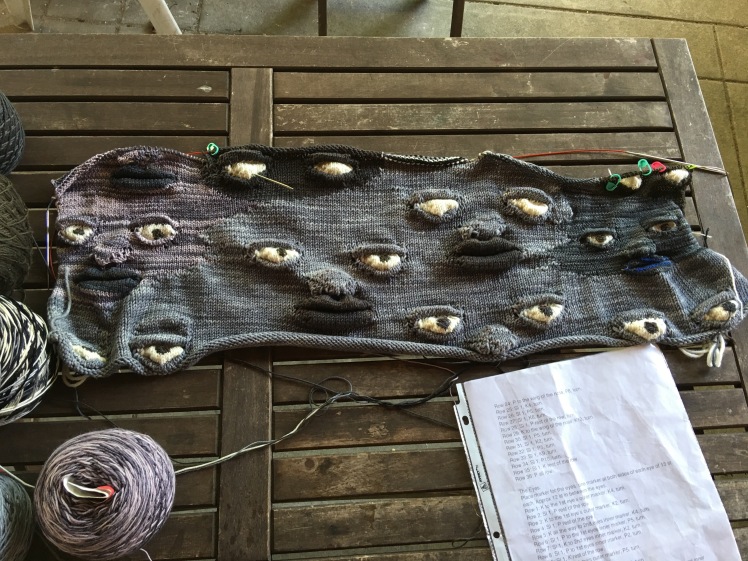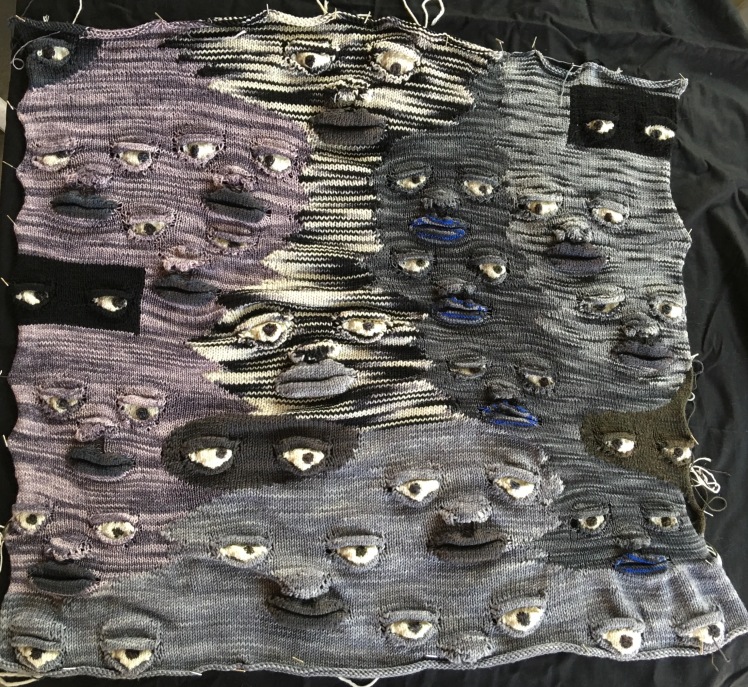When I first saw Katarina Brieditis’ knitted face pattern, the earworm was automatic and instantaneous. Without even thinking about it, The Doors’ song “People Are Strange” started playing in my brain and has stayed there for the last seven months:
People are strange when you’re a stranger
Faces look ugly when you’re alone
Women seem wicked when you’re unwanted
Streets are uneven when you’re downWhen you’re strange
Faces come out of the rain
When you’re strange
No one remembers your name
When you’re strange
When you’re strange
When you’re strange
I envisioned knitting a wall hanging of faces of various sizes emerging from a background of streaky gray yarns in various weights and tones, connected by intarsia and scattered over a single fabric rather than made as separate squares and sewn together as I had done for the first faces wallhanging, DNA. As I became more familiar with the pattern, I saw that there were many places within the pattern where the knitter is instructed to knit or purl to the end of the row and return to the opposite side of the face to work on the other side of the nose or another part of the eye. Every place where I left the face I was working on in order to knit or purl to the end of the row was an opportunity to work on another face placed in a different part of the fabric, at a different stage of completion. The tricky part would be to keep track of where I was in the pattern for each separate face, a daunting task in a pattern with about 100 separate operations. While I was working on the component pieces for DNA, I doubted I’d ever understand the pattern well enough to do that, so I kept making one practice face after another, until I realized that those faces were turning into their own separate work of art.

I had many trepidations when I finally turned my attention to Faces Come Out of the Rain. Did I understand the pattern well enough to be able to juggle many faces at different stages of completion, all being knit simultaneously? And all that intarsia, which I hadn’t done since my first knitting era ended in the 1990’s, would it be as annoying as I remembered? We were on vacation at the family cottage in northern Michigan when I first cast on. The cottage is my happy place, and I’m always at my most creative when I’m there. So maybe I had actually internalized a fuller understanding of the pattern’s structure than I thought I had while knitting the faces for the DNA piece, or maybe it was the Michigan cottage doing its magic, but I had no problem keeping track of where I was in any part of the pattern, and the intarsia wasn’t onerous. The first progress photo was reassuringly resonant of the disturbing psychological state of displacement and social alienation.

I conceived the message of this piece as a psychological study of loneliness and the state of being a stranger in a strange and hostile land, conditions that everyone has experienced in some way at some time in one’s life. But this was June 2018 in the United States of America, where the current government was separating refugee parents from their children forcibly, deceptively, and punitively, to the horror of anyone who saw the photographs. The piece asks, how does it feel to be a stranger in a strange and hostile land? How would you feel as a stranger in a strange and hostile land? Art pushes people to empathize on a human level with people who are not them or people close to them, and it’s no accident that repressive regimes attack art. Empathy is dangerous to violent authoritarian policies and the regimes that impose them. It’s hard to support morally wrong policy when you feel the pain of people suffering from them even when you personally do not. People who fear empathy as a threat to policies or systems that help only them have to resort to derision and insults (snowflake! libtard! bleeding heart!) to fight back against the danger empathy poses to them.
I began seeing Faces Come Out of the Rain in a political context rather than strictly as a psychological study of loneliness and displacement on the personal level. But there is a point at which the personal becomes political, and on the issue of immigration policy, I’m at that point. The U.S. Citizenship and Immigration Services has removed the phrase “a nation of immigrants” from its mission statement; for all their gaslighting of the history, we remain a nation of immigrants. My grandmother came to the United States from Russia in 1914 at the age of 12 with her slightly older brother Morris. Now young immigrants like them would be called unaccompanied minors. My great-grandmother had arrived in the U.S. several years earlier, leaving my grandmother in the care of an inn-keeping family who put her to work and abused her in some way that she refused to talk about. She came from the heavily Jewish town of Babruysk, which had had a history of pogroms just before she was born, and she told of a couple of incidents in which horsemen came thundering up to the inn and bullied people. My grandmother and Morris were cheated out of the 2nd class passage their mother had paid for, although street-wise Morris managed to talk his way into better accommodations, leaving Grandma by herself in steerage. She had to wait a week in quarantine for her mother to come from Massachusetts, where the previously arrived family members were living, to retrieve her from Ellis Island.
What could any of this could have been like? To have been a child of 8 or 9 left behind by her family, working for people who saw her as an employee rather than as a child in need of protection, schooling, and love? To have crossed the Atlantic in the squalor of steerage? To wait in quarantine, young, female, without money or a word of English, until her mother came to claim her? It’s not much of a stretch to imagine the immigrants of today suffering the same conditions as my grandmother, only worse. Much worse. Immigrants are the toughest, most motivated, hardest working people in American society. It was like that 100 years ago when my grandmother came here and it’s like that now.
My family did well in the United States, thanks to settlement houses that provided my grandmother with basic literacy, plenty of work for people who were willing to accept bad working conditions and wages that were unacceptable to the native born, and a mutually supportive Jewish community of fellow immigrants. Grandma married my grandfather at 18, and they moved to Brooklyn, NY, a few years after having their only child, my father, when she was 19. They owned what would now be called a convenience store, and my father, a bright science-oriented child, went to tuition-free City College, graduating at 20 with a bachelor’s degree in chemistry. He moved to Washington, D.C. to spend the war years working for the Bureau of Standards. My father and mother married young and had five daughters, who grew up in comfortable, assimilated surroundings and all got college educations. This is a typical 20th century American immigration story, in which generations of productive citizens originated from the “chain migration” that the current U.S. regime is now denigrating and criminalizing, thanks to policies designed by one Stephen Miller. His family story is a lot like mine, as his uncle has recounted with the logical conclusion that Stephen Miller is a hypocrite.
These are the thoughts that went into the creation of this particular artwork, although the viewer is free to apply his own experiences to his interpretation of the art. One sees in it whatever he sees. But as they say, the personal is political, and because of my awareness of my own family’s immigration experience, art that expresses the fear and disquiet of being in strange and hostile circumstances is very political. That’s how I see it, but I’m only the artist. The artist doesn’t know everything about his art, or shouldn’t, if the artwork has any complexity. The viewer will have to sort out the ambiguity of whether the faces are the threat or the threatened, frightening or frightened. What are the relationships between the faces and how is the viewer a party in those relationships? Does the viewer look at the faces or are the faces looking at the viewer? What does it mean on the personal level, on the societal level? That’s up to the viewer.
The work in progress at successive stages:






Here it is in its final form.

And a detail shot:

Lastly, I have to thank Melissa Saltzman, owner of Baltimore’s best yarn store Lovelyarns, for her help, support, and advice that I was smart enough to take.

Thank you!
LikeLike
So glad you found it interesting!
LikeLike
Damn. Your text and your artwork are both powerful. Many, many thanks.
LikeLike
Big smile! Thank you for that!
LikeLike
Amazing art work with a very meaningful text. I can’t really express how how this piece of work means to me.
LikeLike
Thank you for reading my post! I’m so glad you liked the work and its ideas!
LikeLike
I just found you as I was surfing here on my computer. Your article describing your family travelling to America is not unlike mine in many ways and your “Faces are strange” knit piece is just amazing. Thank you for both. Oh, and I agree, people are strange.
LikeLike
My grandmother’s story was a very typical one, and people like her and her family, and yours, are who provided the brains and muscles that fueled America’s rise in the 20th century. That social and economic progress won’t be replicated in the 21st without immigrants.
LikeLike